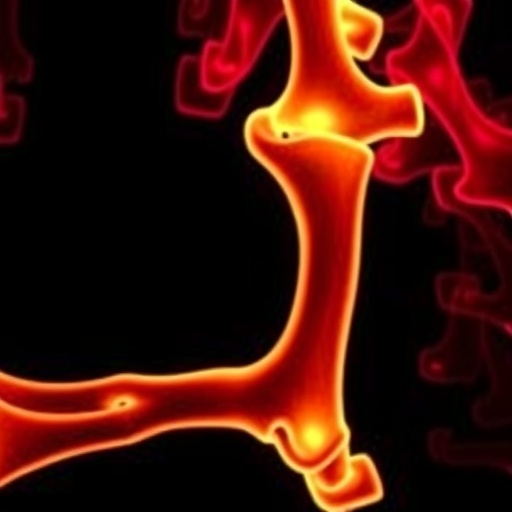The management of dens fractures, particularly in older populations, has emerged as a critical focus of medical research and practice. These injuries, often described as fractures of the dens (or odontoid process) of the second cervical vertebra, pose serious risks for elderly patients due to their potential to cause significant neurological impairment or even life-threatening complications. A recent survey of practices in major trauma centers across the UK and Ireland, led by a group of distinguished researchers including Thackeray, Hutchins, and Rickard, sheds light on the current management strategies employed by geriatricians and trauma specialists facing this challenging condition.
Dens fractures have traditionally been more prevalent in older adults, particularly those who may suffer from osteoporosis or other degenerative conditions that weaken the vertebral structure. The increased fragility of bone in this demographic makes them particularly susceptible to falls, which are a primary cause of such injuries. Understanding how these fractures are currently managed is essential, given the aging population and the implicit increase in the incidence of fragility fractures.
The findings from the study highlight a variety of approaches to treatment, from conservative management, which often includes immobilization and physical therapy, to more invasive procedures such as surgical intervention. It is clear that geriatricians play a pivotal role in the management of dens fractures. Their expertise not only assists in the physical rehabilitation of patients but also encompasses a holistic approach to addressing the multifaceted complications associated with these injuries, including cognitive and emotional health concerns, which are often overlooked.
One of the most striking aspects of the survey revealed by the authors is the inconsistency in treatment protocols across different trauma centers. This variability raises important questions about best practices and the need for standardized guidelines. Particularly concerning is the finding that while some centers have adopted cutting-edge surgical techniques, others continue to rely on outdated methods that may not yield optimal outcomes for patients.
The implications of these management style discrepancies can be profound. Patients who do not receive timely and appropriate treatment are at risk of increased morbidity, prolonged hospitalization, and, in severe cases, mortality. In a healthcare landscape that is increasingly focused on efficiency and patient-centered care, the need for a uniform approach to the management of dens fractures cannot be overstated.
The work done by Thackeray and colleagues is informed by a comprehensive literature review, emphasizing the importance of evidence-based practices in crafting treatment protocols. The integration of current research findings into clinical practice not only improves patient outcomes but also enhances the overall quality of care. Moreover, their findings indicate that continued education and training for medical personnel involved in trauma care is necessary to bridge gaps in knowledge regarding the latest advancements in this area.
Interestingly, the survey also addressed the role of multidisciplinary teams in the treatment of dens fractures. Collaboration among various specialists, including orthopedic surgeons, neurosurgeons, geriatricians, rehabilitation therapists, and nursing staff, can dramatically improve patient outcomes through comprehensive planning and coordinated care. The importance of communication between these parties is essential to ensure that all aspects of a patient’s health and recovery are addressed.
Furthermore, the emotional and psychological repercussions of dens fractures are often understated in clinical settings. Many elderly patients experience significant anxiety or depression following serious injuries. Understanding the psychological impact of such fractures and addressing mental health needs should be an integral part of the treatment plan. The authors advocate for the inclusion of mental health professionals in the care teams of older adults who have suffered injuries of this nature.
The study also indicates a need for ongoing research to explore the long-term consequences of different management strategies for dens fractures. This is particularly important for geriatric populations, where the focus of care must extend beyond mere physical healing to encompass overall life quality. Future research could elucidate not only the direct effects of treatment on recovery rates but also the consequential impacts on a patient’s quality of life, independence, and well-being.
In summary, the management of dens fractures in older adults is a complex issue that requires a multifactorial approach. The findings from Thackeray et al.’s study underline the crucial role of geriatricians and the importance of a standardized treatment framework across healthcare facilities. By fostering a collaborative, evidence-based, and empathetic approach to care, the medical community can improve outcomes for this vulnerable population significantly.
As the demographic landscape evolves, the importance of research such as this cannot be overstated. The academic community and healthcare policymakers alike must take heed of these findings to ensure that as we navigate an aging population, we have the tools and knowledge necessary to provide effective, compassionate, and comprehensive care for all patients facing the challenge of dens fractures.
Subject of Research: Management of dens fractures in older people and the role of the geriatrician.
Article Title: Management of dens fractures in older people and the role of the geriatrician: a survey of practice in UK and Ireland major trauma centres.
Article References:
Thackeray, E., Hutchins, R., Rickard, F. et al. Management of dens fractures in older people and the role of the geriatrician: a survey of practice in UK and Ireland major trauma centres.
Eur Geriatr Med (2025). https://doi.org/10.1007/s41999-025-01342-5
Image Credits: AI Generated
DOI: 20 November 2025
Keywords: Dens fractures, geriatric care, trauma management, elderly health, multidisciplinary approach.




